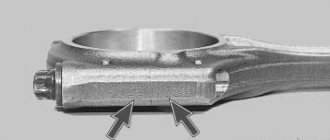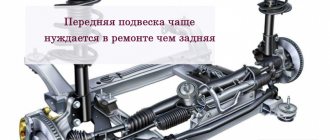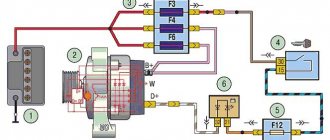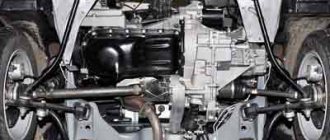Summary data for Lada Priora (before restyling 2013)
The VAZ 2170 (this is exactly the indexing that Priora received) has an improved interior compared to the “ten”, a 16-valve engine with a volume of 1596 cc. see, and a 5-speed manual transmission in all trim levels (in the first trim levels of the sedan and hatchback with an 80 hp engine, an 8-valve engine was installed). In mixed driving mode, the Priora has 100 km. it takes from 6.6 to 7.6 liters. fuel outside the city (depending on the configuration), and in the city - 9.8 liters. The new engine allows you to accelerate to 180 km/h, and to “hundreds” in 12 seconds. This property attracts the attention of fans of high-speed racing, because by working on the engine and tuning the car, you can achieve good sports performance.
Dimensions
The Lada Priora with a hatchback body has the most “modest” dimensions in its series. The length of the five-door version is only 4.24 meters, the three-door version is slightly shorter - 4.21. The height parameters are average, in comparison with the low-set sedan and the high “station wagon” - 1.43 meters.
The width is the same as other body types - 1.68 meters. Almost all versions have a clearance height of 16.8 centimeters, with the exception of the “Sport” line, where it is slightly lower.
How much does Lada Priora weigh?
The weight of the car before restyling in 2013 was as follows:
- The 3-door hatchback coupe, 5-door hatchback and sedan have a curb weight (which includes the weight of a full tank of fuel and the driver) of 1088 kg. In this case, the total weight (i.e., the maximum permissible weight of the vehicle at which it can be operated after being fully loaded) is 1578 kg;
- The station wagon, with the same curb weight, is able to take a little more cargo, and its total weight reaches 1593 kg.
Thus, the station wagon is the most load-carrying of all Priora body types.
Engine change
The Priora engine provides ample opportunities for tuning. Most often, car enthusiasts bore the cylinder block and install shortened pistons in the engine. Such pistons, in turn, require replacing the crankshaft. As a result, the characteristics of the engine are completely changed, and its power can increase by 35%. But there is a minus: fuel consumption will also increase. Therefore, not all car enthusiasts decide to undertake such radical engine tuning. Many people limit themselves to installing mechanical compressors in the engine, which can increase engine power by 10–15%.
Another inexpensive way to increase the dynamic parameters of the Priora is to work with a carburetor. In this device, the jets and acceleration pump are changed (most often, parts manufactured by BOSCH are installed in place of standard spare parts). Then fine adjustment of the fuel level is performed. As a result, the car accelerates twice as fast.
How long does a gas tank last?
With the maximum filling of the gas tank, the Lada Priora, powered by AI-95 (according to the passport!) will travel:
- 438 km in the city;
- 767 km on the highway;
- 597 km combined cycle.
However, the driving range on a full tank is given by us as a rough estimate, since depending on the configuration and modification it may vary slightly, although in all cases the volume of the gas tank is the same: 43 liters.
Body
In all versions of the Priora, the bodywork is mediocre. Drivers and experts had 2 complaints:
Susceptibility to rust. The body is made of ordinary steel, without alloying additives. For this reason, after the first winter it begins to actively rust and it will not be possible to stop this process.
Poor paintwork. Some noticed that it began to fall off in large “chips.” You will have to constantly visit the paint shop to paint over them, otherwise the corrosion process will be unstoppable.
Cargo capacity
Cargo capacity (not payload!) of the Prior varies depending on the body type. So, trunks have different volumes:
- 360 liters – for hatchback and coupe;
- 430 liters - for the sedan;
- 444 liters - for the station wagon.
As we can see, this volume is not very different from the sedan’s, so it’s a very stretch to say that the Priora station wagon was created to solve a wide range of economic problems (relative to other variants of this car). Of course, cargo capacity increases significantly if you fold the back of the rear sofa, or even better, remove the entire rear seat.
Suspension
The suspension is not bad, but this is only if you drive on normal roads, and on all sorts of potholes and speed bumps the suspension becomes very stiff. The fact is that the front pillars, they just stand there and that’s it. First, you drive onto an artificial bump and feel the impact of the struts on the body, and after you move off it, the struts go back and on more expensive cars they are slowed down by gas pressure, but on this one it just bounces back and that’s it.
The chassis of the Lada Priora is no different from the chassis of the VAZ 2108, absolutely everything is the same. The problem with the chassis is that during a sharp turn, the car wheel does not stand straight, but wobbles.
Dimensions of VAZ 2170 and other modifications of Priora
The dimensions of the car are something that needs to be taken into account when purchasing, since the dimensions of parking spaces, garages, turns or entrance arches are not always universal. The height is measured from the extreme point of the front to the extreme point of the rear bumper. The width is measured at the widest point, and the height is measured from the surface of the ground to the highest point of the roof. Roof rails and racks do not fit into the height of the body. Taking this into account, the dimensions of the Priora are as follows:
- The longest body of cars in this family is the sedan. It measures 4350 mm in length. But at the same time it is the lowest - 1420 mm. in height.
- The next longest is the station wagon, with its 4340 mm length. It is the highest in height – 1508 mm.
- The five-door hatchback and three-door coupe are the shortest - 4210 mm. at 1435 mm. in height.
In all four cases, the width of the Priora is the same - 1680 mm. Ground clearance is 165 mm, although in the Priora Sport configuration it is somewhat reduced, but this is no longer so important, since this car is no longer produced in this version.
The salon has become better
Videos and photos of the interior make sure that there are an order of magnitude more changes inside. The new front panel is made from scratch. The attractive contents of expensive trim levels boast the presence of a touch screen, cruise control and a modern multimedia system.
Priora passengers will not get bored, because there is a good entertainment system. This model will not allow you to get lost in an unfamiliar area, as it has a navigation system. For it you will have to pay VAZ 7-10 thousand rubles. It is worth noting that it is capable of communicating with GLONASS and GPS satellites. This is a “Chinese resemblance” to the modern navigation of the 2020 Lada X Rey.
The seats have also changed. The seat backs became 40 mm higher, the shape of the seats changed, and dense lateral support appeared. Now this is a car for drivers with a height of 2 meters, as the manufacturer has increased the range of longitudinal adjustment of the steering wheel by as much as 20 mm.
Modifications of Lada Priora until 2013
VAZ 2170 Lada Priora I generation cars have the following body options: 4-door sedan, 5-door hatchback and station wagon, and 3-door coupe. Depending on the year of manufacture and configuration, engine power may vary, which looks like this.
Engine Lada Priora 2007, sedan, 1st generation
Based on the configuration, sedans before the 2013 restyling are equipped with the following engines:
- 80 “horses”: 8 valves, maximum speed 172 km/h, gasoline consumption – 7.6 liters. for every 100 km. in a mixed cycle.
- 16-valve engine with 89 hp. reaches speeds of up to 176 km/h, consuming 7.3 l/100 km. paths in a mixed cycle. As you can see, in terms of its characteristics, this engine is not much different from its “younger brother,” although it consumes a little less gasoline.
- 16-valve 98-horsepower engine: maximum speed 183 km/h, AI-95 consumption in the combined cycle – 7.2 l/100 km.
Engine Lada Priora 2008, hatchback, 1st generation
5-door hatchbacks have been produced since 2008. Depending on the configuration, they are equipped with:
- 80-horsepower 8-valve engine, delivering the same speed and fuel consumption characteristics as in the case of a sedan equipped with the same engine;
- 16-valve engine with 89 hp, which produces the same speed for a hatchback and consumes the same amount of gasoline as a sedan with the same engine;
- A 98-horsepower 16-valve engine, thanks to which the hatchback completely matches the speed and consumption characteristics of a sedan with the same power plant.
Engine Lada Priora 2008, station wagon, 1st generation
With a station wagon everything is simpler. From the very beginning of production, it had only one, but the most powerful engine at that time, producing 98 l/s, which accelerated the car to 183 km/h and consumed 7.2 liters of gasoline per 100 km. paths in a mixed cycle. Thus, despite the large cargo capacity of the station wagon, its rated speed remains the same as that of other Priors in a different body version, but with the same engine, since the curb weight is the same for all modifications. Probably, when fully loaded, the station wagon will show slightly lower speed or higher fuel consumption characteristics.
Engine Lada Priora 2010, coupe, 1st generation
Since 2010, Priora has received another modification - a three-door coupe-hatchback. Everything with him is also quite simple, because... It is equipped with a 98-horsepower 16-valve engine, giving a top speed of 183 km/h, consuming 7.4 liters of gasoline per 100 km in the combined cycle, i.e. slightly more than all other body modifications. As you can see, the station wagon and coupe do not have such a wide engine variation as the 5-door hatchback and sedan, since cars of such a body are not designed for wide sale, but for specific needs: sports and motor tourism. By the way, the creators of Priora had the idea to launch a convertible into series, but reasonably considering that it would not find its buyer, they abandoned this idea.
Lada Priora is becoming a thing of the past
AvtoVAZ is discontinuing the Lada Priora, or VAZ-2170, a model that replaced the tenth Lad family 11 years ago. In total, during this time, more than 860 thousand Priors were sold in Russia, and more than a million were produced. What do you remember about this car? Has this car become an independent cultural phenomenon? Is an era in the automotive industry passing away with Priora? “Kommersant” was looking for answers to these questions.
Despite the fact that there was no official message from AvtoVAZ regarding the discontinuation of Lada Priora cars, on May 22 the news became one of the most read on the Internet. Earlier, this information was disseminated by the Vedomosti newspaper with reference to a letter received by dealers: Priora will leave the assembly line in July 2022, it is not in the production plan. This scenario, we note, was previously discussed in a number of media at the end of last year.
One of the first “Priors” produced in 2007
Production of the VAZ-2170 sedan (official Lada Priora index) began 11 years ago, in 2007, and development began in 2002. The car became the successor to the VAZ-2110: in fact, the Lada Priora was a deep modernization of the “ten” family (the VAZ-2110 sedan, popularly called the “matryoshka”, as well as the VAZ-2111 station wagon and the VAZ-2112 hatchback), produced in the mid-1990s. x and replaced the 2108 family, or “chisel”.
In addition, the model used some technical innovations that were not available in the tenth family (for example, a 98-horsepower engine instead of the old 78-horsepower). The interior was designed by the Italian engineering firm Carcerano Creative Engineering.
One way or another, in 2008 the five-door Lada Priora hatchback entered the market, a year later the Lada Priora station wagon appeared, and in 2010, production of the small-scale Lada Priora Coupe model began at AvtoVAZ pilot production. In 2011 and 2013, the popular family of cars underwent a slight restyling, and in 2015, Lada Priora received an AMT robotic gearbox for the first time.
Auto expert Philip Berezin on Kommersant FM:
Priora could be called a people's car. A people's car in the Russian sense is still primarily about price. It is cheaper than the vast majority of comparable machines. They turned a blind eye to the fact that it still relates more to AvtoVAZ’s past than to its future. AvtoVAZ still has a very good wide network of dealers throughout Russia, which means that anyone who is not ready to repair a car on their own, if they wanted to turn to some knowledgeable people, could do it in almost any region of Russia. Accordingly, she was popular."
The cheapest Priora (Standard package, 87-horsepower engine) now costs 424.9 thousand rubles, the most expensive (Image package, 106-horsepower engine, power steering, climate system, daytime running lights) - 533.4 thousand rubles.
During its existence, Lada Priora managed to make its mark on the international arena in auto racing. In 2009, the Lada Sport team made its debut in the world racing championship in the Touring class WTCC (World Touring Car Championship), first using Lada 110 cars, which were then replaced by the more modern Lada Priora. Driving a Lada Priora in 2009, British racer James Thompson brought Lada Sport its first points in the WTCC, twice finishing in sixth position in races at the Italian Imola circuit. And earlier in the same season 2009, Lada Priora became the official safety car of the WTCC stage in Portugal on the street circuit in Porto - before that, Russian cars had not been represented in official positions in races of this level.
Restyling Lada Priora 2013
The 2013 restyling consisted of some changes regarding the appearance, some equipment, interior and engine. Among such changes in Prior we will name:
- A slightly modified exterior geometry, which, however, makes no sense to describe, since visually Priora before and after restyling remained almost indistinguishable in appearance;
- Replacing the radiator grille with an elongated “honeycomb”, slightly tilting the car into the now fashionable “organic” style, characterized by biological forms;
- Improved external lighting technology, thanks to which the car’s dimensions have become clearer in the dark. In particular, the area of the reflectors has been increased, LED sections for side lights and brake lights have been added, which are both brighter and more responsive when switched on;
- A dashboard that is implemented differently: instead of four “dials,” the sensor arrows were arranged in two, without compromising functionality. Purely aesthetically it looks better, but from an ergonomic point of view, a lot depends on habit;
- An increased number of pictograms flashing on the dashboard, making it easier to figure out which lighting equipment is faulty;
- An added niche in the center of the dashboard, in which the on-board computer is placed;
- Extended front seat slides, allowing tall drivers and front passengers to adjust their seat positions more flexibly;
- A box that is more spacious in depth to the right of the driver;
- A more attractive three-spoke steering wheel with an airbag under a triangular cover;
- In the “luxury” configuration – leather upholstery based on a combination of auto fabric and eco-leather;
- New door card design.
Also, since 2013, Priors have been produced in a different engine configuration, from which the 80-horsepower engine was removed, but a new 106 l/s engine was added, which, like everyone else, reaches speeds of up to 183 km/h and reduces fuel consumption to 6. 8 – 6.9 liters per hundred km. This engine is equipped with the “luxury” configurations of the Priora. Of course, such a reduction in fuel consumption is very attractive to the consumer. We can only hope that the developers will continue to work in this direction. In addition, the new engine fits well into Euro-3 and Euro-4 environmental standards, thanks to the closely located catalyst. Due to rapid heating, the catalysis of toxic substances occurs more vigorously, as a result of which a lower concentration of them enters the atmosphere.
The restyled Prior also has a drawback (compared to previous editions of this car): the carpet in the trunk is thinner than its predecessors, which is why the noise level while driving is higher. Motorists are advised to take care of additional sound insulation in the trunk. In addition, the curb weight of the car has increased (to 1185 kg), which is by as much as 100 kg. reduced its cargo capabilities, since the maximum weight remained the same - 1593 kg. for a station wagon, and 1578 kg. for other body variations.
Tuning
Although the appearance of the Lada no longer looks downright old, and the level of comfort inside has increased after the next update, many car owners strive to make their car stand out from the crowd. Others want to improve the dynamic performance of Russian cars.
Engine tuning
Despite the fact that the car has a 16-valve engine, which is much more dynamic and powerful than previous versions, you still want to make your vehicle faster. A supercharger compressor comes to the rescue, increasing the power and thrust of the “engine” by 30-50 percent. Installation can be done using fastening units attached to the crankshaft pulley. Power increases due to the enrichment of the fuel-air mixture.
However, do not forget that after this, the “appetite” of the engine will increase significantly, so the fuel system will wear out faster and accumulate paraffin. You can resort to turbocharging. In this case, the efficiency increases, but more fuel is consumed. A mechanical supercharger (supercharger) takes part of the power from the engine, and the turbocharger operates only using exhaust gas energy.
It is also possible to increase the design volume of the cylinders - it will be possible to increase the power of the power unit without any difficulties. Such work is carried out after boring the cylinder blocks.
Appearance tuning
This generation is quite new, so in many cases the car does not require modification, but the car can be transformed with tuning. Some drivers decide to install a hood on stops instead of the outdated hood with a “poker,” which is very convenient. Many people know that the entire AvtoVAZ is “sick” with sound insulation, mainly in the doors.
It is planned to replace locks with a vibration-absorbing structure, where noise-absorbing type bolts are supplied. To enhance the effect, you can use a noise-absorbing material that softens the impact after closing the doors. Owners of Lada Priora use a vinyl base, which is very popular nowadays, to decorate their appearance. If you can spend more money, you can purchase airbrushing.
Some owners purchase a chrome base. Carbon-coated film looks good on any car, especially the new generation film. There is now a new 3D carbon film that imitates a carbon fiber coating throughout the body. The younger generation resorts to stylish body kits for their cars. This includes a spoiler, which gives the sedan a sporty look and improves aerodynamic performance.
Fans of high-quality exhaust system sound can be advised to install a new muffler that has power and a beastly look. You can also install improvements regarding the headlights, for example, angel eyes, eyelashes, and so on.
Tuning the interior
You can install more comfortable sports-type seats, LED lighting for various parts of the interior, buy new covers, and so on. Some drivers install buttons on the transmission tunnel.
Many car owners are dissatisfied with the standard interior lighting, so you can demonstrate standard lamps and place an LED strip there
It is important not to overdo it, otherwise the whole interior will be in bright colors and this can even be distracting
Configurations of Lada Priora VAZ 2170 and other modifications
VAZ 2170 is known in the following configurations:
- “Standard” is the most budget package. It lacks: audio radio, speakers, air conditioning, rear headrests, immobilizer, central locking, heated front seats, electric drive and heated exterior mirrors, fog lights, remote trunk release. The front windows are electric, the rear windows are mechanical. The engine is 81 hp, which has been discontinued since 2013, and at the moment there are no longer orders for this configuration;
- “Norma”, which is equipped with an 87-, and after restyling - only a 98- and 106-power engine. Available: audio preparation, on-board computer, electric heating and electric drive of exterior mirrors, immobilizer, anti-theft alarm and all the elements of the “standard” equipment plus some new equipment. This configuration is in greatest demand due to its price niche. When you need a car “yesterday”, you have to buy what you have enough money for now, and everyone else has to retrofit the car in the process.
- "Norma+". In fact, this is the same standard for which one or more items of equipment are set: air conditioning, audio radio with speakers, ABS + BAS, child seat mounts, heated front seats and windshield;
- “Lux” is the most rich in functionality. It has everything that the “norm+” has, and in addition: side airbags, an airbag for the front passenger, rear and front electric windows, a navigator, a multimedia system, cruise control, parking sensors, fog lights, a rain sensor, a climate system , alloy wheels, heated front seats;
- “Sport” is a special package that increases the “sports” component. This is an aerodynamic body kit: a pronounced bumper with a spoiler, side sills, a diffuser rear bumper, and a wing on the trunk lid. The wheels with narrow profile tires are also different. Ground clearance, curb weight (up to 1080 kg) and maximum weight (up to 1500 kg) have been reduced. The interior has also been transformed: side supports have been added along the edges of the seats with red stitched seams, carbon fiber inserts, and a leather steering wheel. Air conditioning, radio, and a full set of electric windows are included. However, the production of sports Prioras was limited and today they are discontinued, although they can be found here and there on the highway, and most often these are Priora coupes.
Of course, this is not a complete, but only an indicative overview of the configurations of the Lada Priora, which is hardly possible to present in its entirety within the confines of one article. In addition, the equipment also differs somewhat depending on the body type. For example:
- Prior station wagons have roof rails, brackets on the wheel arches of the trunk, for which cargo can be strapped;
- For the coupe body, folding backrests and a reinforced frame of the front seats have been developed.
Appearance
And the design of the Lada Priora hatchback 2016 turned out to be very impressive. The designers created a completely new honeycomb structure in the radiator grille. Now it is distinguished by a menacing grin, which is emphasized by the chrome edging.
Regarding optics, LED bulbs have appeared as brake lights and rear parking lights. The shape of the optics has also changed - the rear side lights have become more elongated and slightly squinted.
The changes affected the rear bumper - here you can see a completely original design with energy-absorbing inserts. The stamping of the bends on the front bumper has changed.
That's all the changes that affected the exterior of the people's car. But this is a great success for AvtoVAZ. Just look at these new mirrors, which make the car look more dynamic. 14-inch alloy wheels add style.











